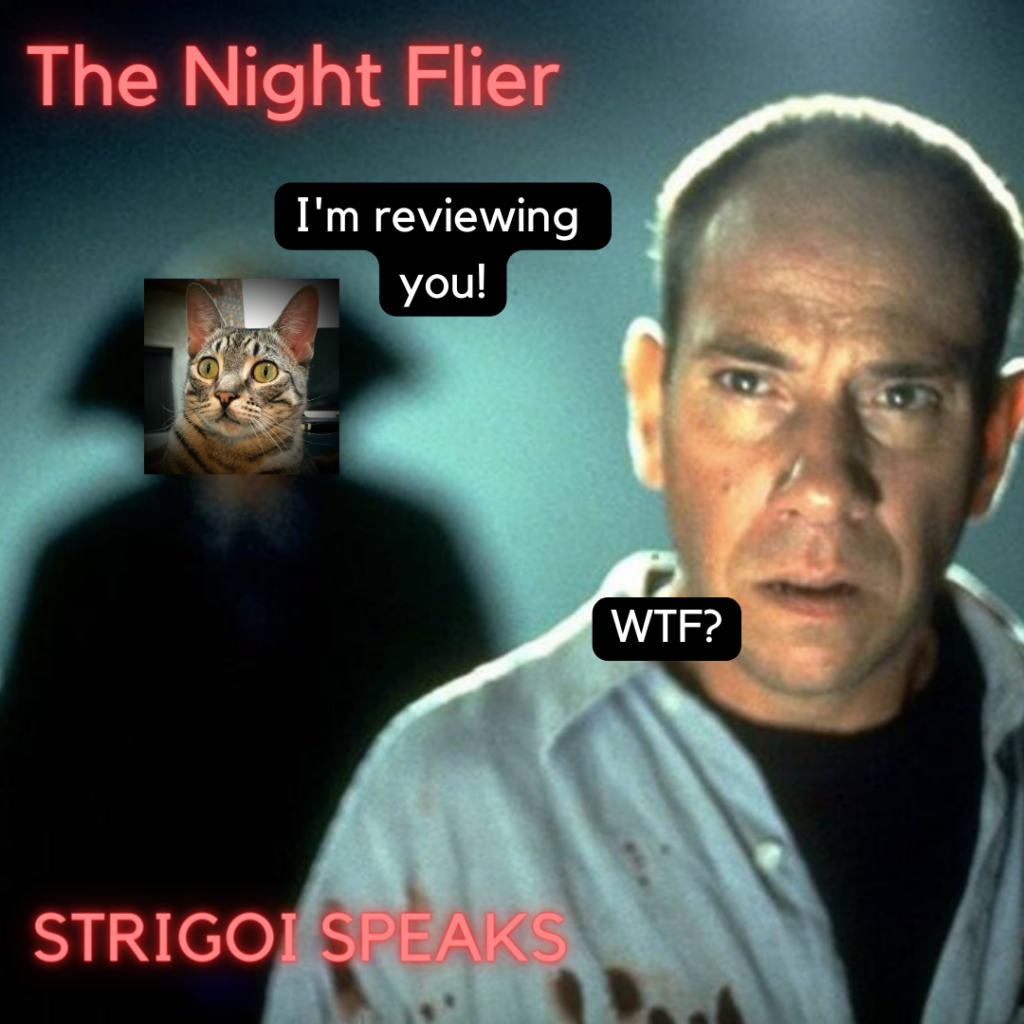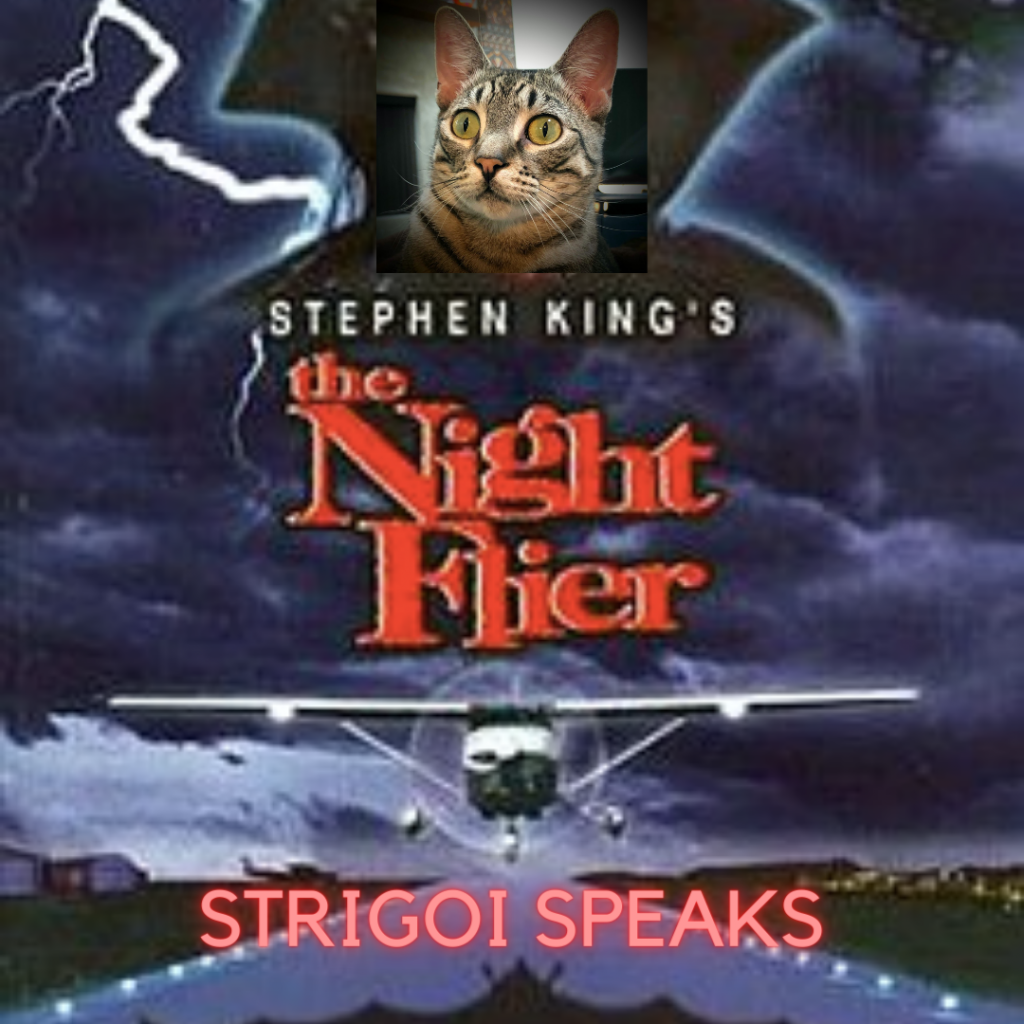

Just when I thought I’d seen every decent vampire film, I came across The Night Flier (1997). This hidden gem is based on a short story by Stephen King, which I admit, I haven’t read. Still, I can see and appreciate King’s craftsmanship–the plot is so sincere and artless that it’s clearly his design. In stubbornly maintaining the traditions of vampire lore in the context of aviation–a place where they don’t seem to belong–he reinvigorates the myth, blowing off the dust to give us something new and surprisingly creepy. Aside from the creative storyline, the film offers great practical effects and, for viewers of a certain age, some fun 90s’ nostalgia. And now for a word of warning: When you meet Richard Dees, the main character, and spend a few moments with him in the newsroom, you may be ready to skip The Night Flier. I strongly encourage you to stay with it! Any discomfort he inspires is outweighed by the overall experience of this underappreciated film.
In The Night Flier, Dees, a macho journalist for the sensationalist rag, Inside View, investigates a series of murders at rural airports. The killer operates a black Cessna, descends only at night, and leaves his victims drained of blood. Could this mysterious pilot be a vampire?
The Night Flier’s plot seems like the elaboration of a child’s fantasy; and it’s this bold simplicity that I found original and refreshing. Imagine a conversation with a 10-year-old kid, a precocious horror fan, who is familiar with Universal’s classic monsters. You both agree that vampires are at the top of the creature pantheon; and so how, you ask, could they ever be improved? To this question, our juvenile interlocutor would readily respond, “With airplanes, of course.” Of course. The idea of a vampire flying into remote airfields at night, gorging on blood, and sleeping in his plane during the day is so ridiculous that it just might work. The movie actually got me thinking about the logistics of how such a feeding routine could continue undetected. If, as Dees says, drug dealers do it all the time, then why not a practiced supernatural pilot? And when it comes to this pilot’s attire and aircraft design, it’s as if our 10-year old were consulted. Based on the killer’s name–an allusion to Tod Brownings’ Dracula–and the photographs that Dee finds, it appears that Dwight Renfield was transformed sometime after 1931. In the pictures, we see him standing proudly by his plane in an old-timey aviator costume. But as any kid knows, you can’t be a vampire with clothes like that; you need the proper uniform as set out by Lugosi. And so, displaying an endearing sense of playfulness, our killer raids Universal’s closet, trading in his goggles, scarf, and bomber jacket for a black cape with red lining and a medallion on a ribbon. In keeping with this gothic aesthetic, his black Cessna is an aerial version of Dracula’s castle, complete with heavy velvet window drapery and silk curtain tassels.
The Night Flier is a literal translation of the vampire myth into a new context. This vampire hasn’t lost any of the old powers–he has strength, immortality, and the ability to control minds; nor has he developed any new skills that would allow him to better navigate the modern world: He can’t walk in daylight, face mirrors, eat garlic, or withstand stakes. In other words, he is Dracula–without alteration–on a plane. It’s incredibly unsophisticated. But it’s this directness of movement–lifting an historically-situated monster and placing him somewhere else– that makes the story so successful.
In the movie, King’s plot plays out in 1996, when The Night Flier was filmed, and the trappings of that decade can’t be ignored. Whether or not you find it pleasantly nostalgic or painfully dated will depend on your age. 80s’ productions resonate with the distant world of my childhood; and the gulf separating me from that past is so vast that I can enjoy its strangeness–the hair, the makeup, the clothes! The look is vivid and unmistakable. Not so, with the 90s, or at least that’s what I thought until last year. Up to that time, when I watched movies like Scream, The Guardian, Candyman, and so on, they seemed blandly contemporary, visually nondescript and somehow cheap–maybe because of the lower resolution? My inability to recognize the style has to do, I suspect, with the fact that I was in high school and college when they came out. Those years were formative for me, and their signature mode–in clothes, attitude, etc–seemed evergreen, current even 20+ years later. But not anymore. My 45th birthday was a tipping point, and on the other side of it, I could finally see the over-plucked brows, brown-based lipstick, and baggy men’s jeans upheld by overcinched belts. Enough time has elapsed that I can immediately identify and fondly chuckle at the fashion choices. And I did a lot of this while watching The Night Flier. The mise-en-scene of the newspaper office is pure 90s, and the main characters are straight out of a Gap catalog. While I am in a perfect position to admire The Night Flier’s aesthetic, other viewers may feel that it hasn’t aged well.
One throwback that I could have done without was Dees. While his aggressive douchebaggery would have been over the top even then, I can easily imagine a more moderate version of his conduct being tolerated in the 90s’ workplace. Since then, that kind of eruptive personality has been stifled by the intensification of corporate culture and, for that, I am grateful. It’s hard to watch Dees and you may be tempted to quit the film because of his abrasiveness. Before you bail, however, know this–though Dees is the main character, we’re not expected to sympathize with him. Without a doubt, he crosses the line of acceptable behavior. But it’s through his deviance that he becomes integral to the plot. Stay the course with The Night Flier and you will be rewarded!